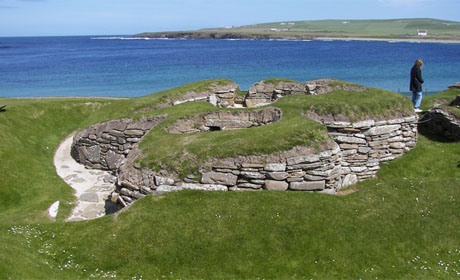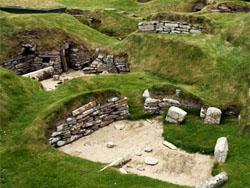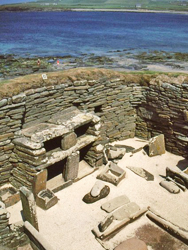Mainland, Orkney, Scotland

Skara Brae is a stone-built Neolithic settlement in Orkney.
It gained UNESCO World Heritage Site status as one of four sites making up ‘The Heart of Neolithic Orkney’.
"On the far curving shore of the bay lies Skara Brae, hazy
through the sea-haar."
George Mackay Brown - Rockpools and Daffodils
The Discovery of Skara Brae

On the southern shore of the Bay o' Skaill, in the West Mainland parish of Sandwick, is the Neolithic village of Skara Brae - one of Orkney's most-visited ancient sites and regarded by many as one of the most remarkable monuments in Europe.
In the winter of 1850, a great storm battered Orkney. There was nothing particularly unusual about that, but on this occasion, the combination of wind and and extremely high tides stripped the grass from a large mound, then known as "Skerrabra". This revealed the outline of a number of stone buildings — something that intrigued the local laird, William Watt of Skaill, who embarked on an excavation of the site.
In 1868, after the remains of four ancient houses had been unearthed, work at Skerrabra was abandoned. The settlement remained undisturbed until 1925, when another storm damaged some of the previously-excavated structures. A sea-wall was built to preserve these remains, but during the construction work, yet more ancient buildings were discovered.
'Modern' investigations
 Further excavations followed and, between 1928 and 1930, the dwellings we see today were released from their protective cocoons. At the time, the village was thought to be an Iron Age settlement, dating from around 500BC — but this was no Pictish village. Radiocarbon dating in the early 1970s confirmed that the settlement dated from the late Neolithic — inhabited for around 600 years, between 3200BC and 2200BC.
Further excavations followed and, between 1928 and 1930, the dwellings we see today were released from their protective cocoons. At the time, the village was thought to be an Iron Age settlement, dating from around 500BC — but this was no Pictish village. Radiocarbon dating in the early 1970s confirmed that the settlement dated from the late Neolithic — inhabited for around 600 years, between 3200BC and 2200BC.
Today, Skerrabra — or Skara Brae as it has become known — survives as eight dwellings, linked together by a series of low, covered passages. Because of the protection offered by the sand that covered the settlement for 4,000 years, the buildings, and their contents, are incredibly well-preserved. Not only are the walls of the structures still standing, and alleyways roofed with their original stone slabs, but the interior fittings of each house give an unparalleled glimpse of life as it was in Neolithic Orkney. Each house shares the same basic design - a large square room, with a central fireplace, a bed on either side and a shelved dresser on the wall opposite the doorway.
In its lifetime, Skara Brae became embedded in its own rubbish and this, together with the encroaching sand dunes, meant the village was gradually abandoned. Thereafter, the settlement was gradually covered by a drifting wall of sand that hid it from sight for over 40 centuries. But the elements that exposed Skara Brae to the world are also the its greatest nemesis. The village remains under constant threat by coastal erosion and the onslaught of the sand and sea. In addition, the increasing number of visitors to the site annually are causing problems. Steps are being taken, however, to alleviate, or minimise, this damage.
Text courtesy of the Orkneyjar website